Do you dream of turning your garden into a tropical paradise but worry about the maintenance? If you’re like me and love the lushness of tropical gardens but want to keep things simple, you’re in the right place.
Over the years, I’ve found plants that give that tropical vibe without needing too much care. Today, I’m sharing 20 must-have tropical plants that are easy to care for and easy to find at your local nursery.
And if you want to make things even easier, consider a no-dig approach to keep your soil healthy with minimal effort. Let’s dive into bringing the tropics to your garden.
1. Golden Cane Palm (Dypsis lutescens)
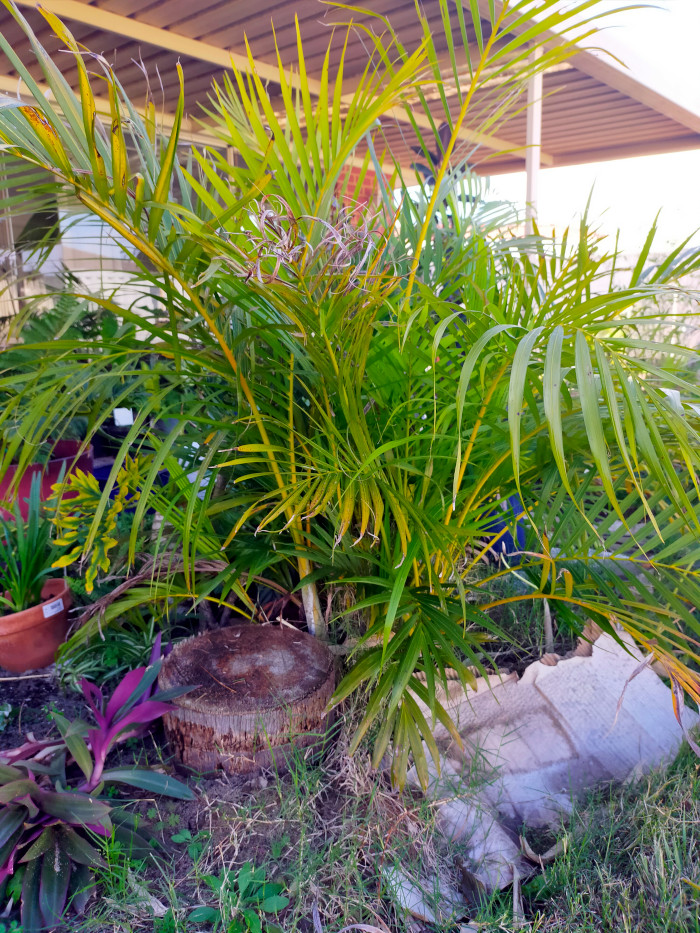
Straight to the top of my list is the golden cane palm. This popular plant is commonly found in nurseries or garden centers, though availability can vary depending on where you are. They’re often sold affordably as larger plants in clusters, making it easy to create an instant tropical effect in your garden.
Golden cane palms are known for their yellowing stalks in full sun, hence the name. However, they also thrive in shadier spots, where they maintain their lush green appearance. Here in Perth, they’re a staple thanks to their tolerance of dry, hot climates. They don’t drop fronds like many other plants, and they’re highly drought-tolerant, making them even more ideal for low-maintenance gardens.
As they grow taller, golden cane palms tend to spread out more, so they might not create a dense canopy. But they’re still an excellent addition to any tropical garden.
Key Characteristics
- Height: 1.8 to 3.7m (6 to 12ft)
- Light: Full sun to partial shade
- Watering: Moderate; allow soil to slightly dry
- Soil: Well-drained, sandy soil
- Toxicity: Non-toxic to pets and humans
Tip: You can divide golden cane palms to create more plants that will produce additional pups. Younger plants or pups are easier to divide and propagate compared to older plants, which don’t transplant as easily.
2. Frangipani (Plumeria)
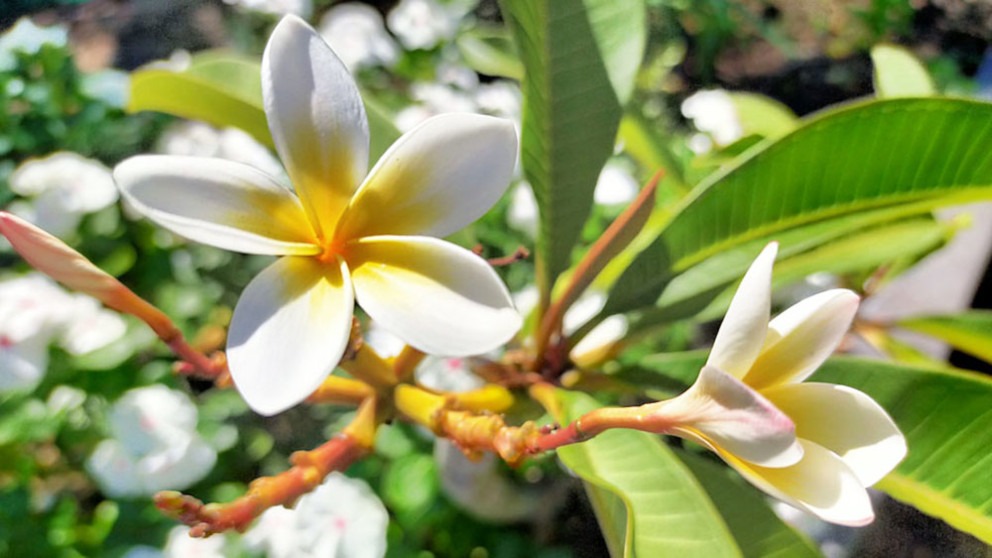
Pretty much an invincible plant, the frangipani tolerates very dry, hot conditions but also thrives in tropical environments. While it’s a slow grower, it more than makes up for that with its ease of propagation. I’ve even successfully grown propagations from branches left out on people’s verges for weeks.
Frangipanis come in various varieties and colors, but they’re most notable for their elegant, fragrant flowers that beautifully contrast against their sparse stems. They thrive in full sun, and if given enough time to grow, they make an excellent canopy plant, allowing dappled light to filter through to the plants below.
In winter, they tend to lose their foliage, which can actually help bring more light to plants beneath them during the darker months.
Key Characteristics
- Height: 1 to 9m (3 to 30ft)
- Light: Full sun
- Watering: Moderate; allow soil to dry between waterings
- Soil: Well-drained, sandy soil
- Toxicity: Non-toxic to pets and humans
Tip: Frangipanis make good feature plants, so space them apart from each other to add interest and avoid overwhelming the landscape. I find that when grown closely together, they don’t look as good because the stems tend to be bare and brown.
3. Agave (Agave spp.)
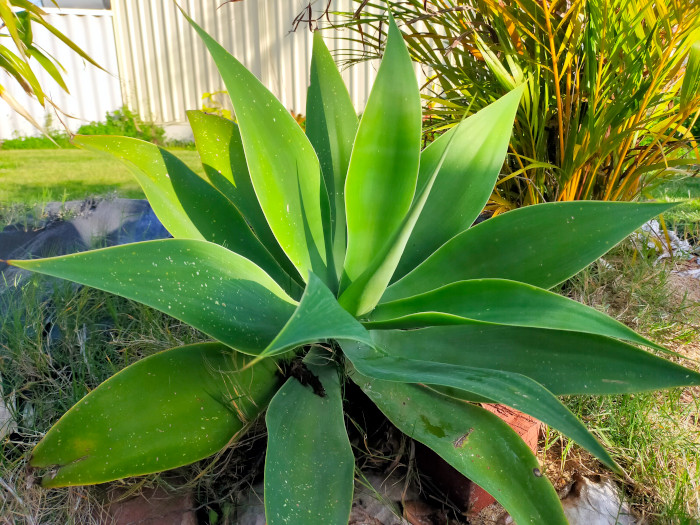
When it comes to low maintenance, few plants can rival the agave plants. Normally found in arid desert locations, they thrive in full sun and are highly drought-tolerant. Despite this, many varieties do well in tropical areas. Their large leaves and interesting shape give any garden a tropical feel.
Agave plants are slow-growing and don’t shed foliage, so once they’re established, they practically take care of themselves. They only flower once in their lifetime—I’ve had mine for years without seeing a bloom. When they do flower, the plant will die, but they produce plenty of pups that will grow into new plants.
Speaking of sizes, there are quite a variety—you can find very small to huge agaves depending on the species and variety, making it versatile for any spot in the garden.
Key Characteristics
- Height: 0.3-3m (1-10ft)
- Light: Full sun
- Watering: Low; water sparingly
- Soil: Well-drained, sandy soil
- Toxicity: Mildly toxic to pets
Tip: Some agaves can produce sharp spines, so do your research and don’t plant it near a pathway if it will be quite spiky.
4. Bird of Paradise (Strelitzia reginae)
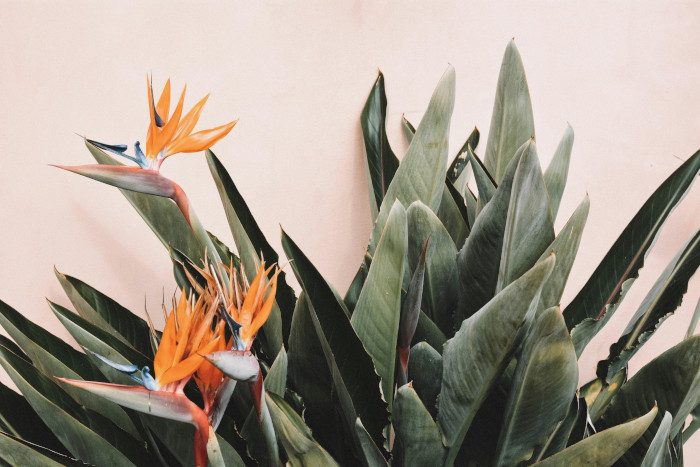
The Strelitzia reginae, commonly known as the smaller Bird of Paradise, is a popular choice for adding a tropical vibe both indoors and outdoors. It thrives in full sun and is drought-tolerant, making it a low-maintenance option for gardens and homes alike.
This plant can grow quite large, with long, striking leaves that spread out beautifully. While it grows well in pots, it will need plenty of light to produce its characteristic flowers.
Another variety to consider is the Strelitzia nicolai, or the giant Bird of Paradise. This variety can grow to an impressive size and is visually stunning, but its larger size and the tendency for dead leaves to remain attached make it higher maintenance in my opinion.
On the other hand, the reginae variety doesn’t have this issue and is slower-growing, making it much easier to manage in the long run.
Key Characteristics
- Height: 1.5-1.8m (5-6ft)
- Light: Bright indirect to full sun
- Watering: Moderate; allow soil to dry out between waterings
- Soil: Well-draining, loamy soil
- Toxicity: Non-toxic to pets and humans
Tip: Bird of Paradise plants are great feature plants. They tend to spread out much more as they grow compared to when you first buy them smaller in the store, so plant them in an area with plenty of room.
5. Dracaena (Dracaena spp.)
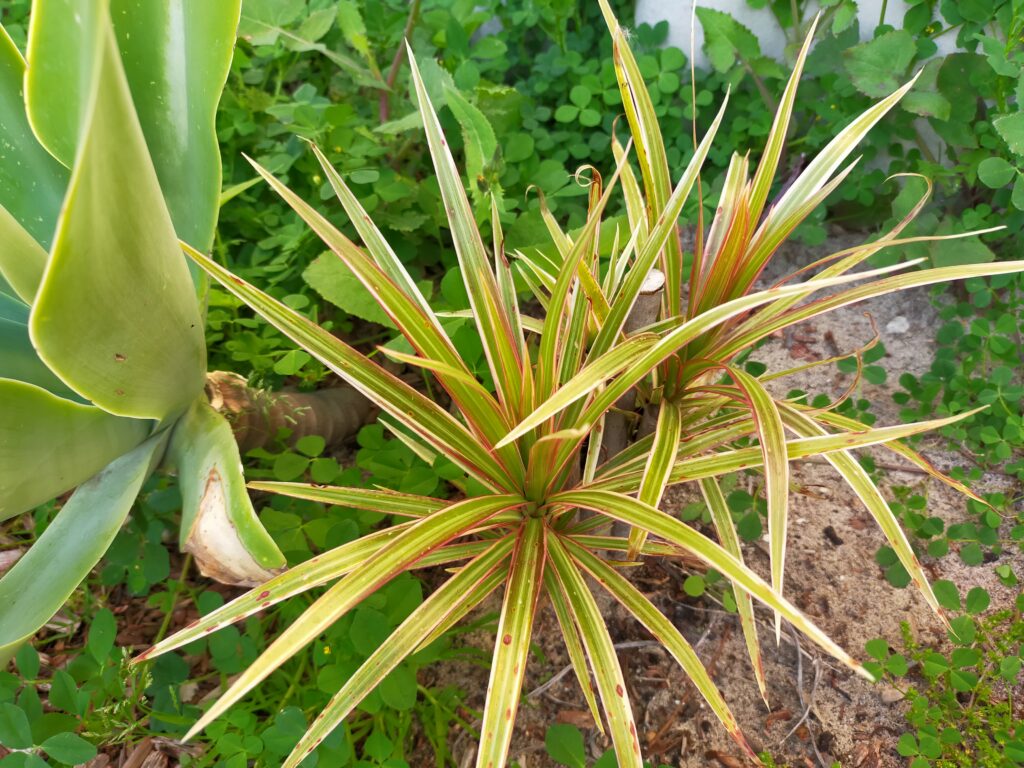
Dracaenas are versatile and hardy plants that thrive in a variety of conditions. Many species do well in low light, making them ideal for indoors or shady parts of the garden. However, they also thrive in full sun, which is one of the reasons they’re so adaptable.
Their striking, sword-shaped leaves add a point of interest to the garden. To me, they almost look like they’re from another planet.
Dracaenas are drought-tolerant, making them a great choice for busy or forgetful gardeners. They come in many different varieties and sizes, but their slow growth means they’re easy to manage and won’t require much pruning at all. Like the agaves, I practically just leave them in my garden and never have to worry about them.
Key Characteristics
- Height: 1.8 to 3.7m (6 to 12ft)
- Light: Full sun to partial shade
- Watering: Moderate; allow soil to slightly dry between watering
- Soil: Well-draining, sandy soil
- Toxicity: Generally non-toxic to pets and humans (check variety)
Tip: If your Dracaena dries out and shrivels up, you can cut it down to the base of the plant, and it may grow new shoots.
6. Agapanthus (Agapanthus spp.)
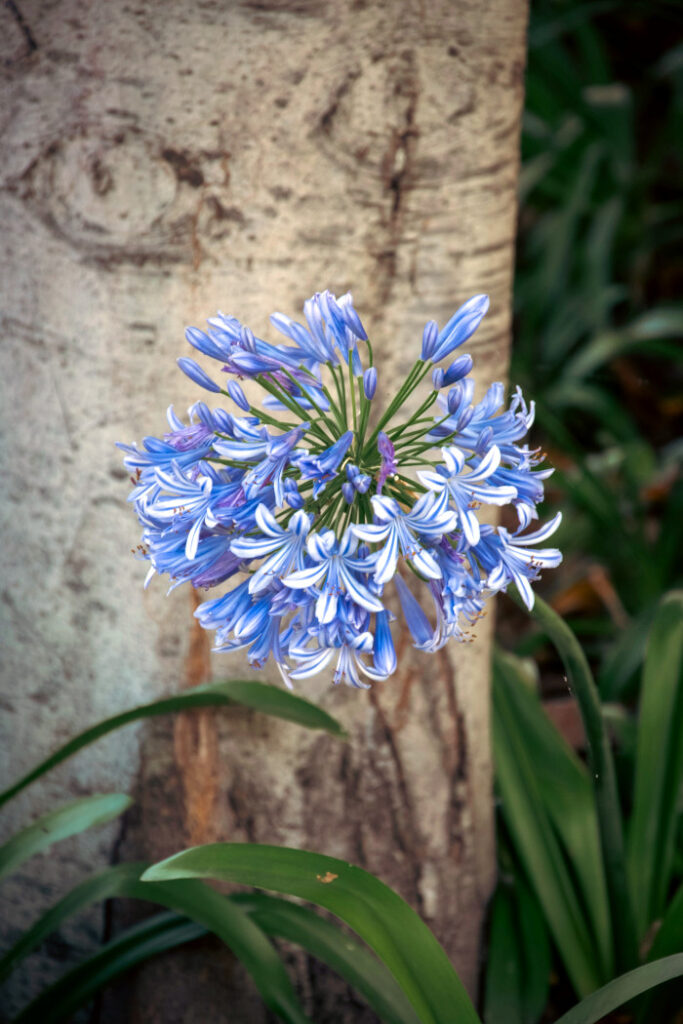
Agapanthus, commonly known as African lilies, are small and hardy plants. Like the frangipani, I’ve collected plants left out on the verge, planted them in my yard and they have easily recovered. They are known for their tall, slender stems with spheres of bright coloured flowers on top.
These plants prefer full sun but can tolerate partial shade making them quite flexible. They are also drought-tolerant once established and are not fussy about soil types.
Agapanthus will grow new shoots and form clumps over time so its good to give them a bit of room between plants. These clumps can easily be divided and used to grow new plants (for when you don’t find free Agapanthus on the verge).
Key Characteristics
- Height: 0.6 to 1.2m (2 to 4ft)
- Light: Full sun to partial shade
- Watering: Moderate; drought-tolerant once established
- Soil: Well-draining, sandy soil
- Toxicity: Mildly toxic to pets and humans if ingested
Tip: Agapanthus look great when mass planted, you will often see them used for garden borders.
7. Canna Lilies (Canna spp.)
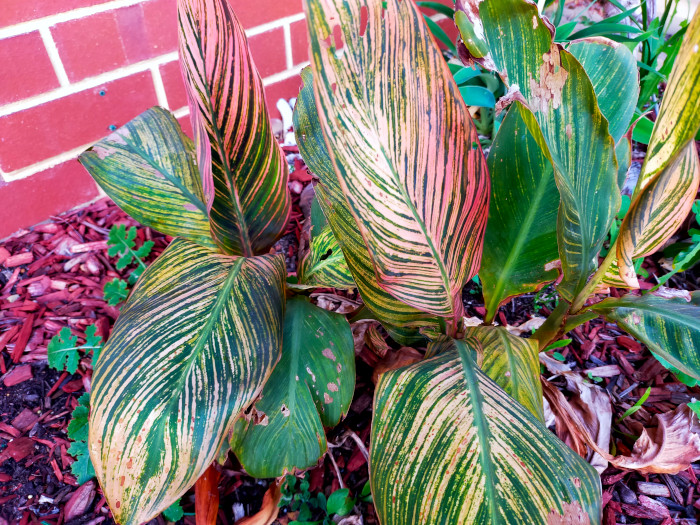
I was first introduced to Canna Lilies when I was allowed to take some spares home during spring cleaning for my horticulture class. Since then, I’ve grown many different varieties in my garden.
They thrive in warm climates like here in Perth and are known for their beautiful flowers. Some varieties also have striking foliage with different textures and colours. For these reasons, they are good for attracting pollinators to your garden.
Canna Lilies do best in full sun and benefit from regular watering. While they can survive drying out, the foliage will suffer. To my surprise, they can also thrive in aquatic settings, making them a nice feature plant for ponds or water gardens.
Propagation is simple with Canna Lilies; you can divide them by the rhizome and plant them elsewhere. However, they generally do not tolerate transplanting very well, and the foliage will probably die back. But don’t fret, new shoots will grow, and the plant will eventually return to a healthy, lush appearance.
Key Characteristics
- Height: 0.6 to 1.8m (2 to 6ft)
- Light: Full sun
- Watering: Regular watering; benefits from consistent moisture
- Soil: loamy soil; adaptable to aquatic settings
- Toxicity: Non-toxic to pets and humans
Tip: Canna Lilies are not frost tolerant, so if you live in a cooler climate, consider digging up the rhizomes and storing them indoors during winter.
8. Rhoeo (Tradescantia spathacea)
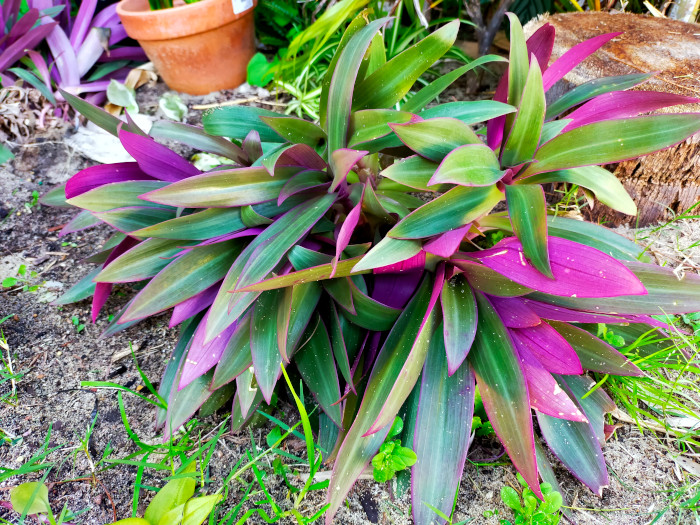
You might know it as Moses in the Cradle, but whatever you call it, I see these plants everywhere here. I accidentally got mine by bringing a pot plant from my mum’s house, and one hitchhiked in the pot. I pulled it out and stuck it in the ground, and it grew really well. I never water or care for it at all; it just seems to do well.
These plants spread out and produce a lot of new shoots quite quickly. I find that you can pull apart each shoot and easily start a whole new plant from it. I like to use them to fill in spaces in pots and other areas of the garden. They seem to be hardy in both sun and shade, but in very hot weather, they might suffer a little.
Key Characteristics
- Height: 0.3 to 0.6m (1 to 2ft)
- Light: Full sun to partial shade
- Watering: Low; very drought-tolerant
- Soil: Well-draining, loamy soil
- Toxicity: Mildly toxic to pets and humans if ingested
Tip: If your Rhoeo is looking a little worse for wear, consider pulling it apart and cutting back some of the growth. This will encourage it to regrow fresh, healthy new leaves.
9. Sword Fern (Nephrolepis exaltata)
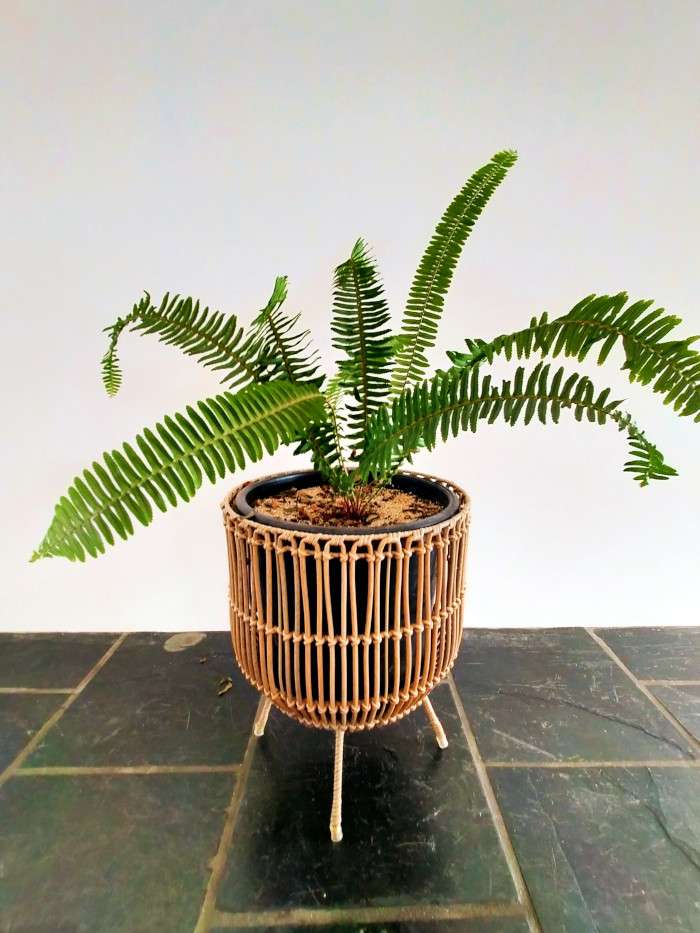
Ferns are a great way to add a tropical, lush look to a garden, and my gold standard is the sword fern (Nephrolepis exaltata). Native to Australia, if you can’t find this fern, a good substitute is the Boston fern (Nephrolepis exaltata var. bostoniensis). Both ferns are known for their hardiness and feature long, bushy fronds that can fill in gaps and blend various elements of the garden together.
While ferns have a reputation for being difficult to look after, and it can sometimes be hard to find information for troubleshooting their issues, I find sword ferns quite easy to manage. They require very little watering and fertilizing, making them suitable for both beginners and experienced gardeners. Sword ferns thrive in the shadier parts of the garden but can also tolerate some sun, although too much direct sunlight may scorch their fronds.
I have propagated many of these plants and continue to do so because I enjoy them so much. They produce runners from the mother plant that can easily be pulled off and grown into new plants. Also, if I want a more immediate effect, I sometimes divide a larger, bushy plant rather than waiting for a runner to grow.
Key Characteristics
- Height: 0.3 to 1m (1 to 3ft)
- Light: Partial to full shade; tolerates some sun
- Watering: Moderate; prefers consistently moist soil
- Soil: Well-draining, loamy soil; prefers a slightly acidic pH
- Toxicity: Non-toxic to pets and humans
Tip: Get creative with your ferns by hanging them in baskets, their trailing fronds will add depth and help to create that tropical ambience.
10. Tiger Grass (Thysanolaena maxima)
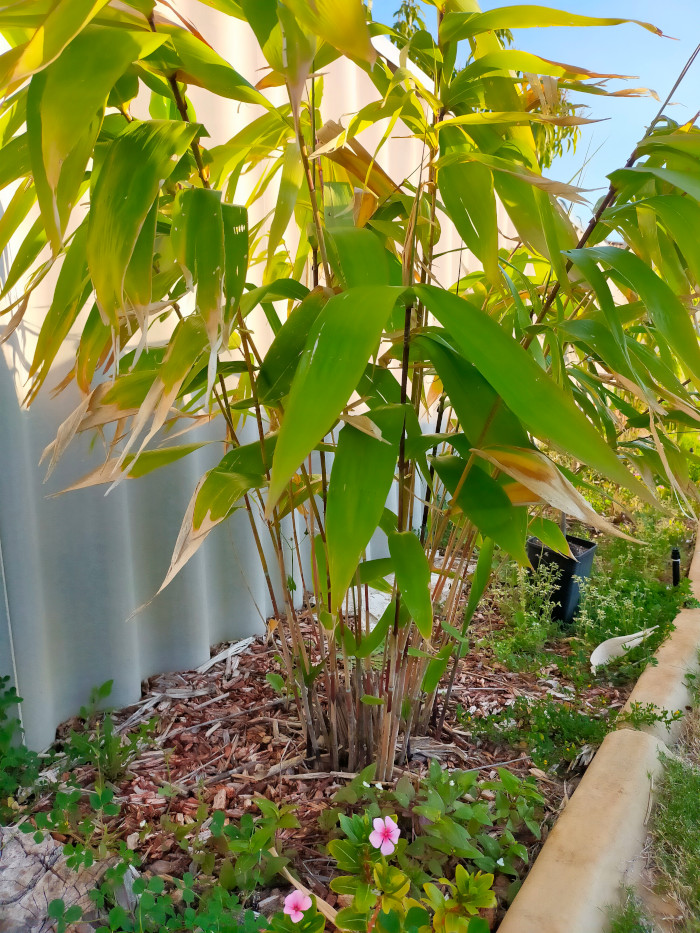
It’s quite hard to find bamboo here, and the bamboo available can be quite expensive. Luckily, there is a bamboo-like substitute that works great for tropical gardens: tiger grass. While it’s not actually a bamboo, it behaves similarly, growing quickly with long, bamboo-like stems in a vertical manner. Because it can grow fairly tall, tiger grass is excellent for creating shade for other plants to thrive underneath.
In my experience, as tiger grass matures, it can have a tendency to lean or fall over, but this varies from plant to plant. If it does fall over, you can stake it up and wrap it with fishing line or something similar; it won’t be obvious that it’s being supported.
Tiger grass is quite drought-tolerant once established and thrives in sunny locations. If you want to propagate it, you can divide the plant, but it’s not an easy task, especially with a mature specimen. The rhizomes are very tough, so be prepared to use an axe and work up a sweat.
Key Characteristics
- Height: 1.2 to 3.0m (4 to 10ft)
- Light: Full sun to partial shade
- Watering: Moderate; drought-tolerant once established
- Soil: Well-draining, loamy soil
- Toxicity: Non-toxic to pets and humans
Tip: If your tiger grass is getting a bit messy, cut it down to ground level. It will regrow very quickly, giving you a fresh, tidy appearance.
11. Tree Philodendron (Philodendron selloum)

Also known as Philodendron bipinnatifidum, I came across this plant by accident. I thought I was buying a regular Philodendron, but over time it grew into a huge plant, and I was initially unsure what it was. Eventually, I identified it by its ability to tolerate the sun so well, even in my hot, sunny climate. Because of this, it’s a great choice for those sunnier areas of your garden, though it also tolerates shady spots just fine.
While it can get quite large, I find it’s not a fast grower, so I wouldn’t worry about it becoming a tree anytime soon. What it will provide are large, glossy leaves with interesting shapes, adding a lovely tropical vibe to your garden.
It doesn’t seem too fussy with watering; I water it more frequently during hot weather, but apart from that, I let it do its own thing. In terms of soil, I suggest using rich, nutrient-dense soil because, with those large leaves, it requires more nutrients to thrive.
You can propagate it by taking pups that grow off it, but I find this can be a bit hit or miss in terms of success. Also, it doesn’t produce many pups; mine has only produced one in about two years, so if you do get a pup, make sure to treat it well!
Key Characteristics
- Height: 1.8 to 3.7m (6 to 12ft)
- Light: Full sun to partial shade
- Watering: Moderate; more frequent during hot weather
- Soil: Well-draining, loamy soil
- Toxicity: Toxic to pets and people if ingested
Tip: Tree Philodendrons are good for pots, adding height and lush greenery to your indoor collection or patio. Their striking foliage not only elevates your space but also creates a tropical ambiance, making them an eye-catching focal point.
12. Bungalow Palm (Archontophoenix cunninghamiana)

Since I use many Golden Cane Palms in my garden, I wanted to add another palm that can handle full sun and is quite hardy, bringing some variety to my canopy. The Bungalow Palm fits the bill perfectly and will make an excellent addition to your garden.
One of its main features is its potential for impressive height; it can grow very tall, but if you’re buying from a nursery, don’t expect that to happen anytime soon. While it is quite hardy and drought-tolerant once established, I find that they do require a bit of extra care during their first year or two to help them settle in, especially if your in a hot climate.
Palms don’t need much in terms of soil quality, and the sandy soil we have here works just fine for them. With the right conditions, the Bungalow Palm can thrive and become a stunning focal point in your garden.
Key Characteristics
- Height: 10 to 20m (30 to 65ft)
- Light: Full sun to partial shade
- Watering: Moderate; drought-tolerant once established
- Soil: Well-draining, sandy soil
- Toxicity: Non-toxic to pets and humans
Tip: Try planting colourful foliage plants near your Bungalow Palm to create a contrast with the palm’s feathery fronds. This combination will enhance the tropical feel of your garden.
13. Clumping Bamboo (Fargesia robusta)
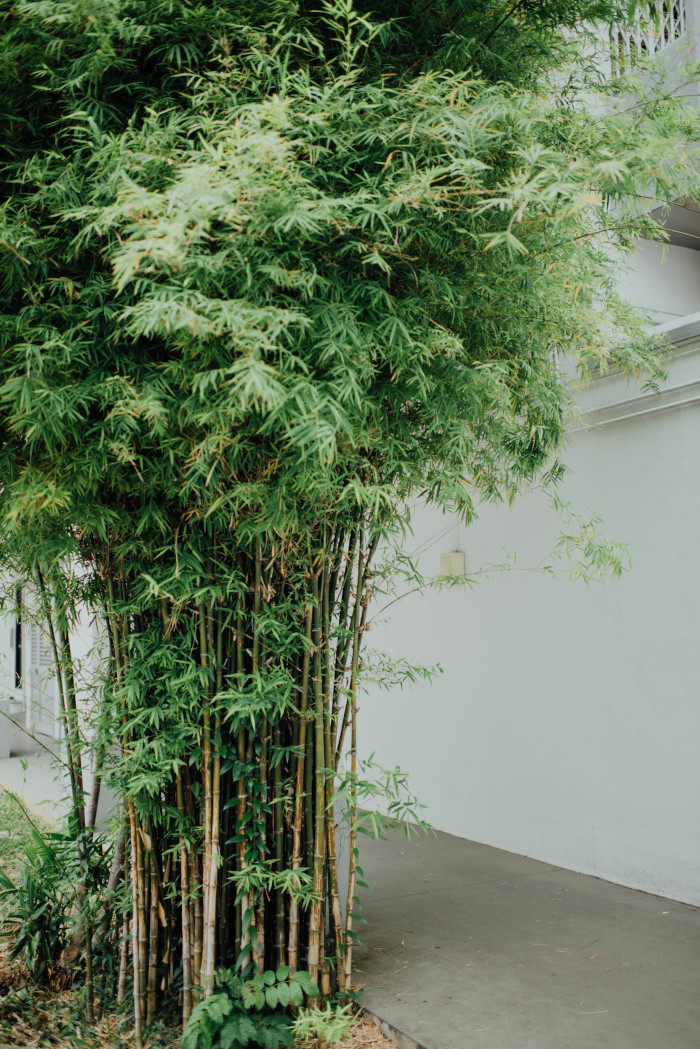
Bamboo is one of the classic plants we associate with a tropical garden. I also love the sound of the wind blowing through it. It’s a great choice if you’re looking to add height quickly, as it can grow up to 1 meter every few weeks.
However, bamboo can be difficult to control as it spreads via underground runners. For a low-maintenance option, select a clumping variety such as Fargesia robusta or Bambusa multiplex. While bamboo plants tend to drop their leaves, they still a good option for your garden. Personally, I leave the leaves and cuttings in my garden as part of my chop-and-drop method, which helps retain nutrients and moisture in the soil.
Bamboo generally requires more water than most of the other plants on our list, so keep that in mind. To help with this, I suggest using rich soil that holds moisture well but still drains a bit freely. Since bamboo grows so fast, it will need the extra nutrients that good soil can provide.
Key Characteristics
- Height: 3 to 5m (10 to 16ft)
- Light: Full sun to partial shade
- Watering: Moderate to high; needs consistent moisture
- Soil: Well-draining, loamy soil
- Toxicity: Non-toxic to pets and humans
Tip: Due to its fast growth, bamboo is a good choice for hedging and creating privacy barriers.
14. Rubber Tree (Ficus elastica)

Better known as an indoor plant, the rubber tree or rubber plant can also make a nice addition to an outdoor space. I’ve been growing and propagating them for many years, keeping them in pots to help control their growth.
They have an aggressive root system, which can be damaging to pipes and foundations. However, if you keep them in pots or have plenty of space for them to grow, they are a very hardy plant. In the wild, they can reach enormous heights of 20 meters (65ft) or more.
Rubber trees tend to thrive in shadier conditions but can adapt to full sun. Initially, their leaves may burn, but as new leaves emerge, they become harder and more resilient. I find they don’t require much watering and maintain their large, glossy leaves with minimal fuss. They are also easy to prune to keep them at a manageable size, and the cuttings can be used to propagate more plants.
Key Characteristics
- Height: Up to 20m (65ft) in the wild; typically smaller in pots
- Light: Thrives in partial shade; can adapt to full sun
- Watering: Low to moderate; prefers soil to dry out between waterings
- Soil: Well-drained, loamy soil
- Toxicity: Toxic to pets and humans if ingested
Tip: You can cut notches into the stem to encourage more shoots to grow, creating a bushier plant.
15. Wandering Jew (Tradescantia zebrina)
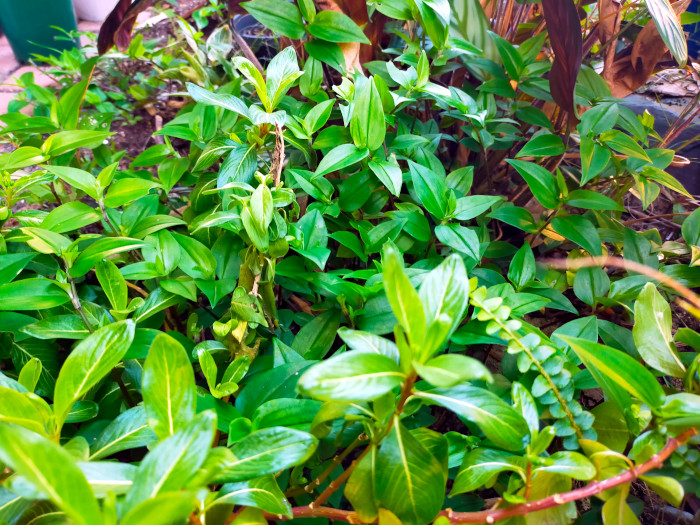
The wandering Jew is a great plant for tropical gardens, and you might also encounter Tradescantia pallida, which is a similar variety. I came across this in a store and was immediately drawn to its bright purple colour, interesting textures, and trailing stems. It works great in a hanging basket, as a spiller in a pot, or even as a ground cover.
It spreads quite rapidly, so if used as a ground cover, it can get a little out of control. Fortunately, it’s very easy to pull out due to its weak and shallow root system. Despite this, it proves to be quite hardy and resilient. It prefers a shady location and isn’t too fussy about watering.
Key Characteristics
- Height: 15-30cm (6-12in)
- Light: Prefers partial shade; can tolerate full sun but may scorch
- Watering: Moderate; allow the soil to dry slightly between waterings
- Soil: Well-draining, loamy soil
- Toxicity: Mildly toxic to pets if ingested
Tip: You can take cuttings and place them back near the mother plant to create a bushier appearance.
16. Croton (Codiaeum variegatum)
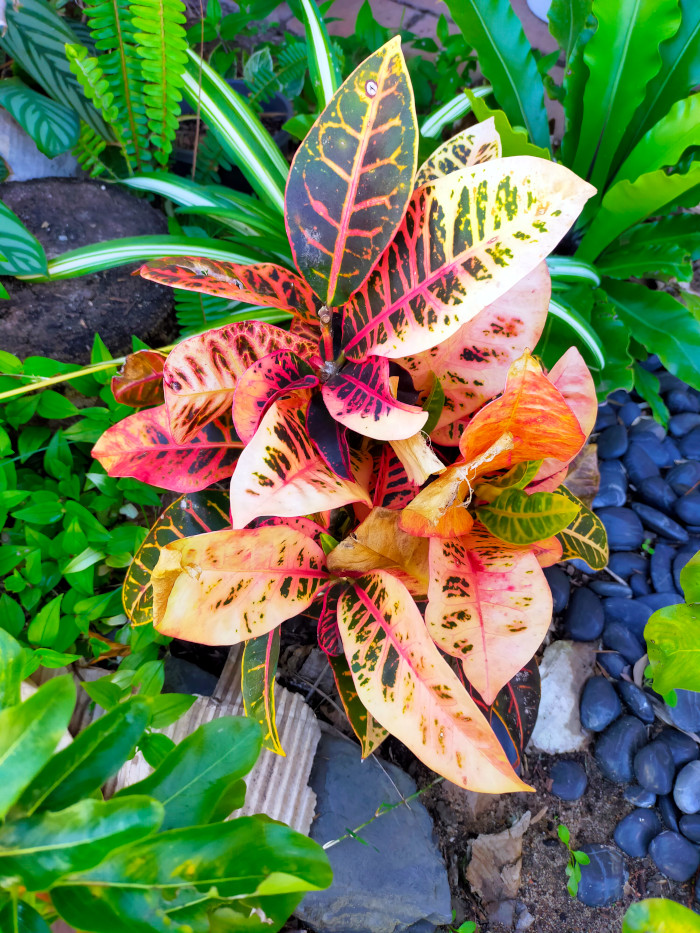
Tropical gardens tend to be dominated by large green leaves, but adding vibrant plants can enhance their appeal. Crotons are fantastic for introducing a pop of color, as they come in various shapes and striking hues. I always feel tempted to buy another every time I visit a garden center and must resist!
These plants thrive in partial sun to partial shade locations, but for the best variegation, they need at least some dappled sunlight. If you live in a cooler or darker environment, they can tolerate full sun, but in my dry, arid climate, I find that full sun tends to be too intense for them.
Crotons can grow fairly large, but they are very slow-growing. If you’re looking for a small to medium-sized plant, you can rest assured it will stay that way for many years. I am quite a fan of the ‘Petra’ cultivar myself, with its larger leaves and interesting texture.
Key Characteristics
- Height: 30-120cm (12-48in), depending on the variety
- Light: Partial sun to partial shade; prefers dappled sunlight for best colour
- Watering: Moderate; allow the top inch of soil to dry out between waterings
- Soil: Well-draining, loamy soil
- Toxicity: Mildly toxic to pets and humans if ingested
Tip: If you notice your croton becoming leggy, trim back the excess growth. This will encourage new shoots to develop, giving you a fuller and bushier plant.
17. Shell Ginger (Alpinia zerumbet)
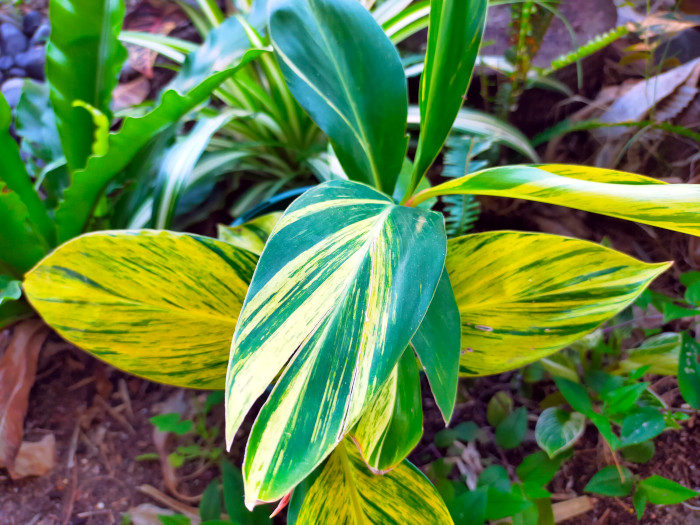
There are several varieties of ginger that do well in a tropical garden, but I find shell ginger to be particularly interesting. It has vibrant and unique striped foliage that adds a spicy touch to your garden, along with a nice aroma and beautiful flowers.
Shell ginger can grow fairly tall, though not excessively, giving a nice bushy appearance. It can be planted in a pot as a feature plant or mass-planted for a cohesive look—either way, it’s always nice to look at.
These plants prefer more water, similar to bamboo, but they are more drought-tolerant once established. They can handle some sunlight, and like crotons, exposure to light helps enhance their attractive variegation. However, they can also survive in shadier locations adding to their versatility.
Shell ginger can be propagated by dividing its rhizomes, similar to the canna lily. When you do this, expect the stem and leaves to die back, but don’t worry—new shoots will eventually emerge.
Key Characteristics
- Height: 1-2m (3-6ft)
- Light: Partial shade; tolerates full sun
- Watering: Moderate; drought-tolerant once established
- Soil: Well-draining, loamy soil
- Toxicity: Non-toxic to pets and humans
Tip: Shell ginger enjoys moisture but also needs its roots to dry out from time to time. If you notice yellowing or brown leaves, it may indicate that the soil is too moist. Cut back on watering and monitor the new growth for signs of improvement.
18. Birds Nest Fern (Asplenium nidus)
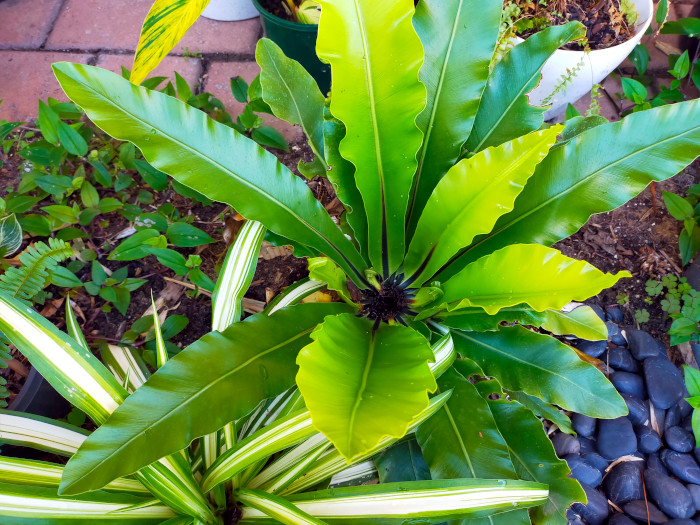
Another fern on our list, the bird’s nest fern, is strongly associated with tropical gardens. While they can be very small, they can grow to a large size given the right conditions. They don’t like full sun; I unfortunately learned this the hard way when some of the fronds of my fern burned to a crisp. I suggest keeping them in a shadier location. That being said, some dappled sunlight is important for them to reach a decent size.
Like many plants on our list, bird’s nest ferns prefer rich, free-draining soil but require constant moisture to keep their leaves in good shape. You usually buy them quite small, but consider the size they can reach and position them appropriately. I find they transplant quite well, so don’t worry if yours outgrows its current spot.
Key Characteristics
- Height: Up to 1m (3ft)
- Light: Shade; avoid full sun
- Watering: Frequent; avoid drying out
- Soil: Well-draining, loamy soil
- Toxicity: Non-toxic to pets and humans
Tip: Bird’s nest ferns are epiphytes, which means they can absorb moisture from the air. Consider growing them in hanging pots or attaching them to tree branches for a unique, jungle-inspired look.
19. Cordyline (Cordyline fruticosa)
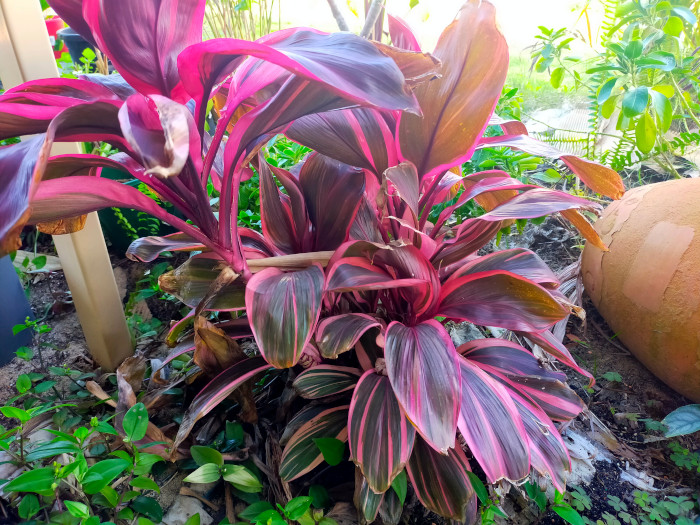
Cordyline is another fantastic plant that adds a pop of colour to your tropical garden. They come in various colours but all feature that unique spiral structure. While they thrive in partial sun to enhance their vibrant hues, in very sunny climates like mine, they can burn a little in full sun. If you’re in a particularly sunny area, consider placing them in a shadier spot where they can flourish.
Cordylines are quite drought-tolerant and don’t require frequent watering, as long as they have rich soil that retains moisture. They tend to produce many pups and side shoots, which can easily be propagated for more plants.
Key Characteristics
- Height: Typically grows between 30 to 120 cm (12 to 48 in), depending on the variety.
- Light: Partial sun; avoid intense full sun
- Watering: Drought-tolerant
- Soil: Well-draining, loamy soil
- Toxicity: Mildly toxic to pets if ingested
Tip: Use plants with contrasting colours and textures, such as large-leaved ferns, to complement Cordyline’s dramatic leaves and make a stunning focal point in your garden.
20. Gardenia (Gardenia jasminoides)
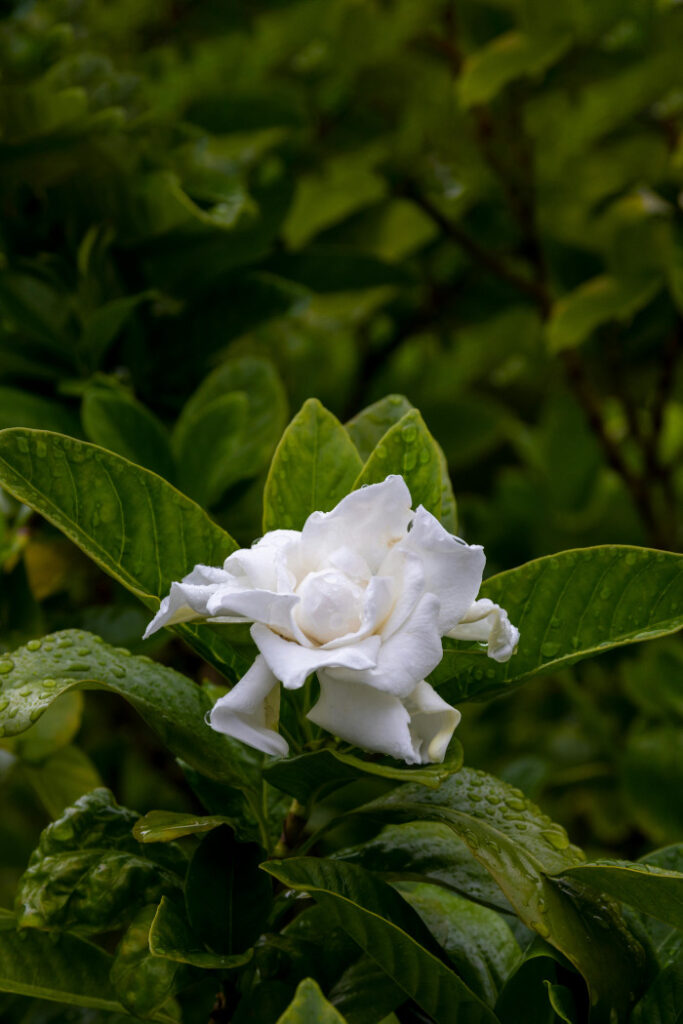
While gardenias are mainly known for their fragrant flowers, their dark leaves and bushy appearance make them a nice low-maintenance plant for your garden. They are my mum’s favorite plant, so I’ve had a lot of experience with them, and in general, I find them fairly easy to care for.
The main two things to get right are acidic soil and plenty of water. You want to use a rich soil mix with lots of organic matter to achieve the right acidity. Acidic potting or soil mixes can usually be found in garden centres, often labelled as mixes for gardenias, camellias, or azaleas.
When it comes to watering, they are fairly thirsty plants, so if you get hot weather, make sure to water them often. Gardenias can tolerate a little sun but do best in a part-shade location protected from the hotter afternoon sun.
Key Characteristics
- Height: 1-2m (3-6.5ft)
- Light: Part shade; avoid hot afternoon sun
- Watering: Frequent, especially in hot weather
- Soil: Well-draining, acidic, loamy soil
- Toxicity: Mildly toxic to pets if ingested
Tip: To encourage more flowers on your gardenia, use a fertilizer with higher phosphorus content. This will promote blooming and overall plant health.
Tropical Plant Care Tips
To ensure your tropical plants thrive, here’s some quick tips:
Sunlight
Different tropical plants have varying light requirements. Some thrive in full sun, while others prefer partial shade. Be sure to place your plants in locations that suit their sunlight needs, and consider providing shade if the sun is too intense.
Watering
Some tropical plants can be quite thirsty, especially in hot weather. Adjust your watering based on the seasons to keep them healthy and hydrated.
Mulching
Adding a thick layer of mulch can help retain moisture in the soil. I recommend wood chips, as they last longer and allow water to penetrate to the soil.
Compost
Tropical plants often prefer rich, loamy soil. Use compost to fill your soil with essential nutrients and increase moisture retention. This is especially beneficial if you’re using a no-dig approach to maintain healthy soil with minimal effort.
Conclusion
Tropical plants can add a stunning visual element to your garden, transforming it into a lush paradise. From the beautiful frangipani to the striking croton, there’s a tropical plant for every part of your garden.
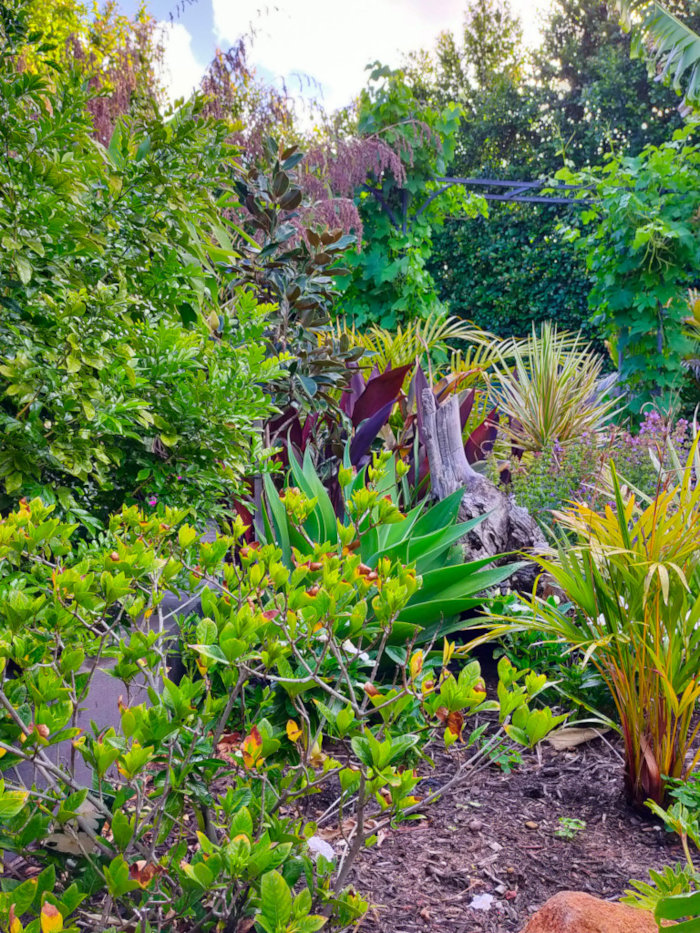
As you think about the best options for your garden, consider which plants will not only thrive in your environment but also fit together to create the atmosphere you want. And if you’re looking to bring some of that tropical charm indoors, check out 10 Remarkably Easy Indoor Plants for a Low-Maintenance Home.
Let us know if any of these plants, or perhaps some other great choices, will be making their way into your garden.

